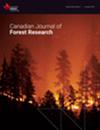Evaluation of branch sampling, ocular assessments, and aerial surveys for estimating spruce budworm defoliation
IF 1.7
3区 农林科学
Q2 FORESTRY
引用次数: 0
Abstract
We compared three methods for estimating current-year spruce budworm (Choristoneura fumiferana Clem.) defoliation from 2014 to 2021 using a network of 99 permanent sample plots in central Gaspé Peninsula, Québec. Percent current-year defoliation was measured by assessing shoots from mid-crown branches, ocular ratings of all individual trees using binoculars, and provincial government aerial surveys. Ocular survey defoliation differed from branch sample defoliation in 5–6 out of 7 years, consistently underestimating defoliation, across the full range of defoliation severity observed. Nested mixed-effects models for fir-spruce combined, balsam fir, white spruce, and black spruce ocular survey defoliation bias resulted in marginal R2 of 0.40, 0.47, 0.82, and 0.86, respectively. Current defoliation severity and its interaction with previous year defoliation and weather conditions significantly affected ocular survey bias. Correspondence of aerial survey estimates and mean plot defoliation occurred in only 43% of all plot-years and ranged from 14–58% in individual years. Differences between aerial survey defoliation and plot values mainly resulted from assigning an adjacent class (e.g., light <30% assigned as moderate 31–70% defoliation) or misplaced defoliation polygon boundaries, suggesting that assignment of aerial survey defoliation to plots or specific ground areas needs ground truth sampling.评估树枝取样、目测评估和空中调查对云杉芽虫落叶的影响
我们在魁北克省加斯佩半岛中部利用 99 个永久性样地组成的网络,比较了三种估算 2014 年至 2021 年云杉芽虫(Choristoneura fumiferana Clem.)当年落叶情况的方法。当年的落叶百分率是通过评估树冠中部的枝条、使用双筒望远镜对所有单棵树进行目测评级以及省政府的空中调查来测量的。在观察到的所有落叶严重程度范围内,7 年中有 5-6 年的目测落叶量与树枝样本落叶量存在差异,始终低估了落叶量。冷杉-云杉组合、香脂冷杉、白云杉和黑云杉目测调查落叶偏差的嵌套混合效应模型的边际 R2 分别为 0.40、0.47、0.82 和 0.86。当前的落叶严重程度及其与前一年落叶和天气条件的交互作用对目测偏差有显著影响。在所有地块年中,仅有 43% 的地块出现了航测估计值与平均地块落叶量的对应关系,个别年份的对应关系从 14% 到 58% 不等。航测落叶量与小区数值之间的差异主要是由于分配了相邻等级(例如,轻度落叶量<30%被分配为中度落叶量31-70%)或落叶多边形边界错位造成的,这表明将航测落叶量分配到小区或特定地面区域需要进行地面实况取样。
本文章由计算机程序翻译,如有差异,请以英文原文为准。
求助全文
约1分钟内获得全文
求助全文
来源期刊
CiteScore
4.20
自引率
9.10%
发文量
109
审稿时长
3 months
期刊介绍:
Published since 1971, the Canadian Journal of Forest Research is a monthly journal that features articles, reviews, notes and concept papers on a broad spectrum of forest sciences, including biometrics, conservation, disturbances, ecology, economics, entomology, genetics, hydrology, management, nutrient cycling, pathology, physiology, remote sensing, silviculture, social sciences, soils, stand dynamics, and wood science, all in relation to the understanding or management of ecosystem services. It also publishes special issues dedicated to a topic of current interest.

 求助内容:
求助内容: 应助结果提醒方式:
应助结果提醒方式:


